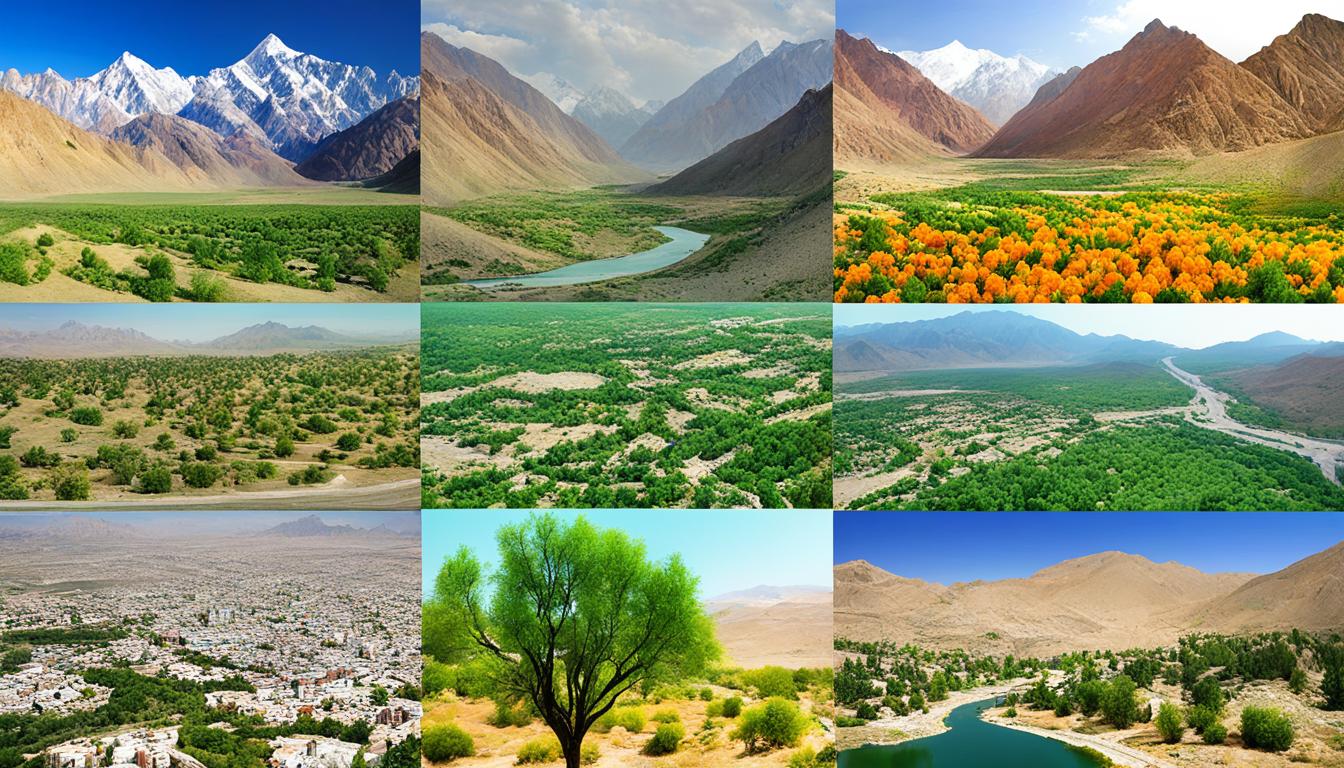Greece Sacred Natural Sites and Biodiversity
Did you know that sacred natural sites (SNS) are recognized as the oldest form of habitat protection in human history? These sites, scattered across the world, have a profound impact on biodiversity conservation. In Greece alone, the preservation of sacred landscapes and their ecological diversity is a matter of great significance. Let’s explore the captivating relationship between Greece’s sacred natural sites and biodiversity conservation.
Key Takeaways:
- Greece’s sacred natural sites have a powerful impact on biodiversity conservation.
- Sacred natural sites are the oldest form of habitat protection in human history.
- Preserving sacred landscapes is essential for protecting Greece’s ecological diversity.
- Sacred natural sites contribute to the preservation of cultural heritage in Greece.
- Understanding the connection between sacred natural sites and biodiversity is crucial for sustainable environmental management in Greece.
The Importance of Sacred Natural Sites
Sacred natural sites, such as sacred groves, forests, and landscapes, have been regarded as the oldest form of habitat protection and conservation of natural resources in human history. These sites hold special spiritual significance for communities and are associated with a wide range of natural features. Sacred natural sites have been found to have the same, or even higher, levels of species richness as official reserves. They act as refugia for endemic, threatened species, preserve old-growth trees and forests, and sometimes represent the only natural or semi-natural habitat patches within highly modified landscapes.
“Sacred natural sites are not only sanctuaries for biodiversity, but also embody the cultural heritage and spiritual values of local communities. Their preservation is vital for both the ecosystems they sustain and the intrinsic connections between people and nature.” – Dr. Maria Papageorgiou, Conservation Biologist
Spiritual Significance and Cultural Heritage Preservation
Sacred natural sites have deep spiritual significance for many cultures around the world. These sites are often associated with stories, rituals, and beliefs that have been passed down through generations. They serve as places of worship, meditation, and connection with the divine. By preserving these sites, we not only protect their ecological value but also safeguard the cultural heritage and traditions of communities.
Habitat Protection and Biodiversity Conservation
One of the key roles of sacred natural sites is habitat protection. These sites provide refuge for a diverse range of species, including endemic and threatened ones. The preservation of old-growth trees and forests within sacred natural sites ensures the survival of critical habitats for many plant and animal species. Moreover, these sites often act as stepping stones or corridors, facilitating the movement of species within fragmented landscapes.
The Beauty of Sacred Natural Sites
Visiting a sacred natural site is a unique experience that allows individuals to connect with nature on a spiritual level. The tranquility, beauty, and unique features of these sites, including ancient trees, pristine landscapes, and sacred water sources, create a sense of awe and reverence. Exploring these sites not only fosters a deeper appreciation for the natural world but also reminds us of the intrinsic value of biodiversity.
Preserving for Future Generations
Preserving sacred natural sites is an investment in our future. By protecting these sites, we ensure that future generations can continue to benefit from their ecological and cultural values. The spiritual teachings and knowledge associated with these sites can guide us towards more sustainable ways of living and maintaining a harmonious relationship with the natural world.
A Call for Conservation
In light of the importance of sacred natural sites, it is crucial to integrate their conservation into broader biodiversity management strategies. Collaborative efforts between communities, conservation organizations, and government agencies can ensure the sustainable protection and management of these sites. By recognizing the spiritual significance, cultural heritage, and ecological value of sacred natural sites, we can work towards a more holistic approach to biodiversity conservation.
| Key Points | Benefits of Sacred Natural Sites |
|---|---|
| Spiritual Significance | Provides a place of worship and connection with the divine |
| Cultural Heritage Preservation | Safeguards the traditions and knowledge of local communities |
| Habitat Protection | Acts as refugia for endemic and threatened species |
| Biodiversity Conservation | Preserves old-growth trees and forests, supporting a wide range of plant and animal species |
| Beauty and Awe | Offers a unique and spiritual connection to the natural world |
| Preservation for Future Generations | Invests in the well-being of future generations and sustainable living |
Recognizing and valuing the importance of sacred natural sites is essential for their conservation. By protecting these sites, we not only preserve their ecological and cultural significance but also contribute to the broader goal of biodiversity conservation.
Global Synthesis on SNS and Biodiversity Conservation
The first global-level synthesis on Greece Sacred Natural Sites and Biodiversity conservation found strong evidence that SNS have a positive effect on biodiversity. However, there are geographical and taxonomical biases in research, with most studies focusing on Asia and Africa and on plants. Further efforts are required to fill these gaps and advance our knowledge of SNS through more systematic research. The positive effects of SNS on taxonomical diversity, vegetation structure, and cultural uses of biodiversity should be recognized in conservation frameworks.
Geographical and Taxonomical Bias
The global synthesis on SNS and biodiversity conservation reveals certain biases in research. Geographically, most studies focus on Asia and Africa, leaving a gap in our understanding of SNS in other regions, such as Greece. Additionally, there is a taxonomical bias, with more research conducted on plants rather than other taxonomic groups like animals or fungi.
“The first global-level synthesis on SNS and biodiversity conservation found strong evidence that SNS have a positive effect on biodiversity.”
These biases hinder our comprehensive understanding of the role of SNS in biodiversity conservation. To address this, future research should aim to include more diverse geographical locations and taxonomic groups, promoting a holistic perspective on SNS and their impacts on biodiversity.
Positive Effects of SNS
Despite these biases, the global synthesis highlights the positive effects of SNS on biodiversity. SNS contribute to taxonomical diversity by providing habitats for a wide range of species. The unique vegetation structure within SNS promotes the coexistence of different plant species and supports diverse ecological interactions. Moreover, SNS often have cultural uses that contribute to the conservation and sustainable use of biodiversity.

| Positive Effects of SNS on Biodiversity | |
|---|---|
| SNS promote taxonomical diversity by providing habitats for a wide range of species | |
| SNS support diverse vegetation structure, enabling the coexistence of different plant species | |
| Cultural uses of biodiversity within SNS contribute to conservation efforts |
Recognizing the positive effects of SNS on biodiversity is crucial for effective conservation strategies. Conservation frameworks should integrate the management and protection of SNS alongside other protected areas, ensuring the preservation of both natural and cultural heritage.
Case Study: Sacred Forests in Epirus, Greece
Sacred forests in Epirus, Greece, hold a unique status due to their association with the Greek Orthodox Church. These forests are protected from exploitation through strict prohibitions enforced by spiritual beliefs and sacred rituals. This special connection has contributed to their preservation and the conservation of their ecological characteristics. Research has revealed that sacred forests exhibit important features that enable their resiliency and recovery after periods of damage and degradation.
Ecological Characteristics of Sacred Forests
Sacred forests exhibit remarkable ecological characteristics that contribute to their conservation. One notable feature is their high resiliency, allowing them to withstand disturbances and bounce back resiliently. This resilience is attributed to the presence of mature trees, which act as a nucleus for seed dispersal, facilitating the establishment and expansion of forest cover across the landscape. These forests play a vital role in maintaining local biodiversity and preserving key ecological relationships.
Forest Recovery and Resilience
Sacred forests have shown exceptional recovery and resilience in the face of disturbances. They possess the ability to recover their ecological functions and biodiversity rapidly. This recovery is attributed to the protective measures enforced within these sacred sites, preventing activities that may cause irreversible damage. The strict conservation practices and respect for nature within sacred forests contribute to their long-term sustainability and the perpetuation of their unique ecological attributes.
Sacred forests in Epirus, Greece, are a testament to the power of spiritual beliefs and sacred rituals in maintaining the ecological health and resilience of natural landscapes. Their preservation not only safeguards the biodiversity within these forests but also contributes to the broader conservation efforts in Greece.
By recognizing the ecological value of sacred forests and incorporating sustainable management practices, we can ensure the long-term preservation of these sacred natural sites and their critical role in biodiversity conservation.

Mt. Athos: A Sacred Peninsula of Biodiversity
Mt. Athos, located in Greece, is home to twenty self-sufficient monasteries that govern the site autonomously. This unique peninsula is recognized as a UNESCO World Heritage site for its harmonious blend of nature and culture.
The steep slopes of Mt. Athos create a diverse landscape, featuring a dense forest of deciduous, coniferous, and Mediterranean scrubland vegetation. This rich biodiversity extends to the flora and fauna that call Mt. Athos their home.
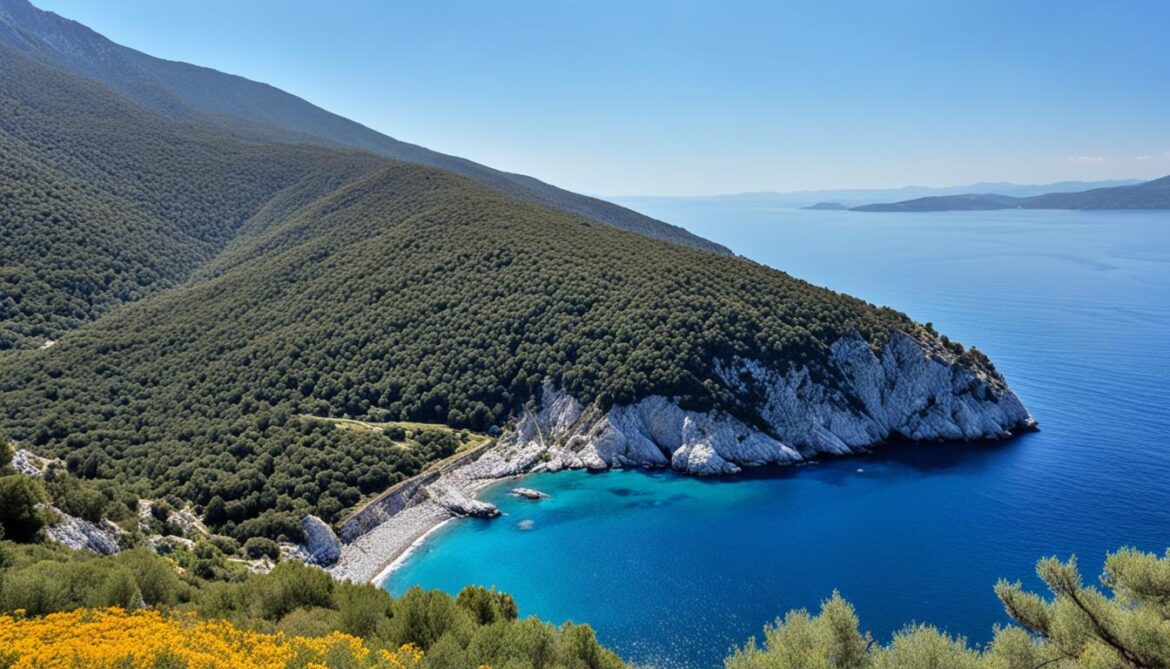
Despite its natural and cultural significance, Mt. Athos faces threats to its biodiversity. Intensified road construction and the risk of wildfires pose challenges to the delicate ecological balance of the area.
Conservation Efforts in Mt. Athos
Efforts to conserve and protect the unique biodiversity of Mt. Athos in Greece are underway through collaborative research and environmental management initiatives. Monks and scientists have joined forces to understand and address the threats facing the local ecosystems.
Each monastery in Mt. Athos has proposed tailored environmental management plans that take into account their unique circumstances. These plans aim to mitigate the impact of human activities on the pristine natural environment of Mt. Athos while preserving its ecological diversity.
One important aspect of these conservation efforts is the consideration of timber extraction. Each monastery acknowledges the need for sustainable practices and has developed timber extraction plans that align with responsible forest management. By implementing these plans, the monastic communities aim to minimize the ecological impact of timber extraction activities.
Furthermore, the implementation of a sustainable certification scheme for timber produced at Mt. Athos is being considered. This certification would ensure that timber extracted from the site adheres to strict environmental standards and is sourced in a sustainable manner.
To effectively manage and protect the unique biodiversity of Mt. Athos, close collaboration with scientific institutions and public services is sought. Through partnerships and knowledge sharing, a comprehensive approach can be developed to safeguard the natural heritage of Mt. Athos for future generations.

The efforts to conserve Mt. Athos reflect the unwavering commitment of the monastic communities to protect this sacred site and its ecological treasures. By prioritizing sustainable environmental management and collaborative approaches, Mt. Athos can continue to thrive as a haven of biodiversity and cultural significance.
| Conservation Efforts in Mt. Athos | Overview |
|---|---|
| Collaborative Research | Monks and scientists work together to understand and mitigate threats |
| Environmental Management | Each monastery proposes tailored plans for sustainable environmental management |
| Timber Extraction | Monasteries develop responsible timber extraction plans |
| Sustainable Certification | Consideration of a certification scheme for sustainable timber |
| Collaboration and Partnerships | Close collaboration with scientific institutions and public services for effective management |
Custodianship and Policy at Mt. Athos
The monastic communities of Mt. Athos play a vital role in the custodianship and management of the site. As the custodians of this sacred land, the monastic communities are responsible for preserving its cultural and natural heritage.
The Holy Community, consisting of representatives from all twenty monasteries, governs issues that affect the entire peninsula. This collaborative governance ensures that decisions are made collectively, considering the needs and interests of all the monastic communities.
Each monastery has the legal responsibility for self-management while complying with Greek laws. This allows the monastic communities to maintain their unique traditions and spiritual practices while fulfilling their obligations as custodians of the land.
The collaboration between the monastic communities and the Greek authorities is crucial in ensuring the effective management and conservation of Mt. Athos. Together, they work to develop and implement policies and regulations that protect the biodiversity and cultural significance of the site.
Recognizing the importance of Mt. Athos as a significant cultural and natural heritage site, the collaboration with UNESCO further strengthens the conservation efforts. The UNESCO recognition highlights the exceptional universal value of Mt. Athos and guides the preservation and sustainable management of the site.
In conclusion, the custodianship and policy at Mt. Athos are essential for the conservation and recognition of its cultural and natural heritage. The monastic communities, in collaboration with Greek authorities and UNESCO, continue to protect and manage this sacred site, ensuring its long-term preservation for future generations.
Results and Recommendations for Mt. Athos Conservation
Through studies and research, several key findings and recommendations have emerged regarding the conservation of Mt. Athos and its rich biodiversity. These findings aim to address the unique challenges faced by the region and ensure the long-term preservation of its natural and cultural heritage.
Monitoring and Mitigation of Threats
In order to safeguard the delicate ecosystems of Mt. Athos, it is imperative to closely monitor and mitigate the impacts of various threats. Road construction, wildfires, and climate change pose significant risks to the local habitats and species. Regular monitoring programs should be implemented to assess the extent of these threats and their impact on the biodiversity of the area. This will enable effective and timely mitigation measures to be undertaken to minimize the negative effects on the ecosystems.
Responsible Forest Management
Responsible forest management practices have a crucial role to play in the conservation of Mt. Athos. Thinning operations can be employed to reduce wildfire risks and enhance species diversity. By selectively removing certain trees, forest resilience can be improved, allowing for healthier growth and regeneration. It is essential to strike a balance between human activities and the preservation of natural habitats, ensuring the sustainable use of forest resources and the protection of biodiversity.
Sustainable Practices
The adoption of sustainable practices is vital for the long-term conservation of Mt. Athos biodiversity and cultural heritage. Raising awareness among local communities, visitors, and stakeholders about the importance of preserving the unique ecosystems and cultural significance is paramount. Encouraging sustainable tourism practices, such as eco-friendly accommodations and responsible visitor behavior, can help reduce the ecological footprint on the site. Moreover, active forest management, including reforestation efforts and the restoration of degraded areas, should be implemented to promote the recovery of the natural habitats.
Cultural Awareness
Cultural awareness plays a significant role in the conservation efforts at Mt. Athos. Recognizing and respecting the spiritual and cultural values associated with the site fosters a deeper understanding of the interconnectedness between people and nature. Incorporating traditional knowledge and practices into conservation strategies can lead to more holistic and effective approaches. Collaboration between local communities, religious authorities, and conservation organizations is essential to ensure the preservation of both the natural and cultural heritage of Mt. Athos.
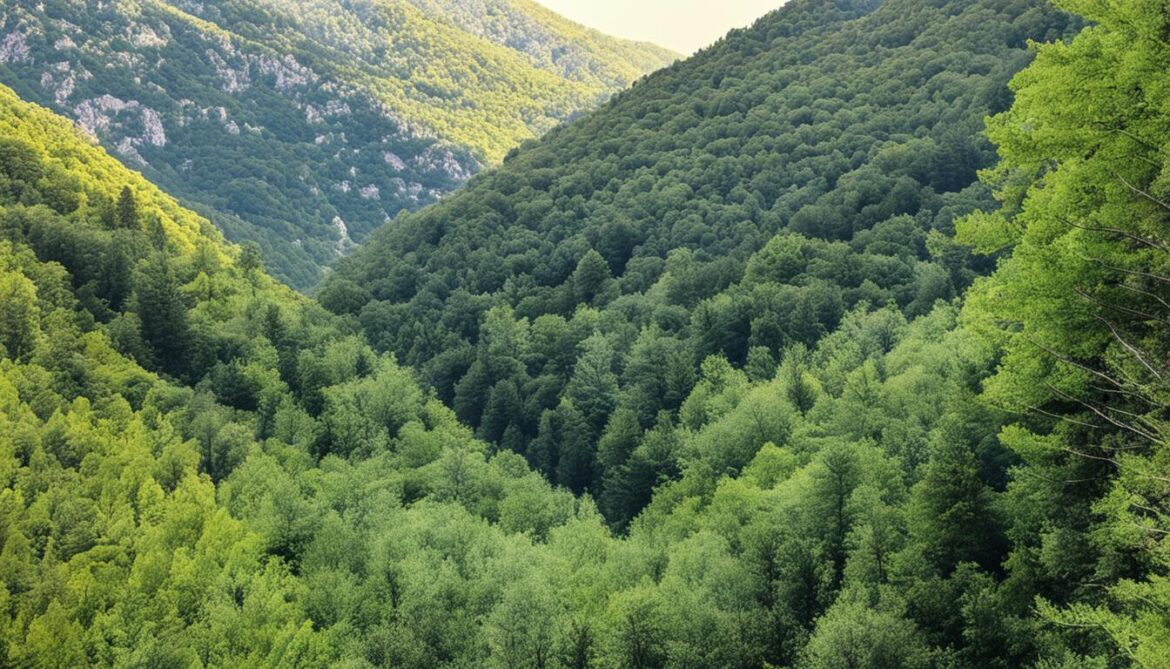
| Recommendations for Mt. Athos Conservation | Benefits |
|---|---|
| Regular monitoring of threats and impacts | Early identification and mitigation of risks to the ecosystems |
| Responsible forest management practices | Reduced wildfire risk and enhanced species diversity |
| Promotion of sustainable practices | Long-term conservation of biodiversity and cultural heritage |
| Recognition and integration of cultural awareness | Preservation of spiritual and cultural values |
Future Prospects for Sacred Natural Sites in Greece
The future of sacred natural sites (SNS) in Greece holds immense potential for the preservation and sustainable management of these invaluable landscapes. Key strategies include the expansion of protected areas to encompass SNS, collaboration with local communities, and the integration of SNS into national and international conservation frameworks.
The expansion of protected areas is crucial to ensure the long-term conservation of SNS in Greece. By including these sacred sites within existing protected areas or designating new ones, their unique cultural and ecological value can be safeguarded. This expansion not only offers legal protection but also enhances the visibility and recognition of SNS on a broader scale.
Collaboration with local communities is essential for the effective management and conservation of SNS. Engaging communities in decision-making processes and empowering them to actively participate in conservation efforts helps foster a sense of ownership and responsibility. Working together with local stakeholders ensures that traditional knowledge and practices are integrated into conservation strategies, resulting in more holistic and sustainable outcomes.
The integration of SNS into national and international conservation frameworks is crucial for their long-term preservation. By recognizing the cultural and ecological significance of these sites within existing legal and policy frameworks, their protection can be prioritized at a higher level. This integration promotes sustainable management practices and provides opportunities for funding and support from national and international conservation organizations.
Ultimately, the future of SNS in Greece relies on a collective effort to recognize their value, protect their ecological integrity, and ensure their cultural significance for generations to come. By expanding protected areas, collaborating with local communities, and integrating SNS into conservation frameworks, Greece can pave the way for a more sustainable and harmonious relationship between humans and nature.
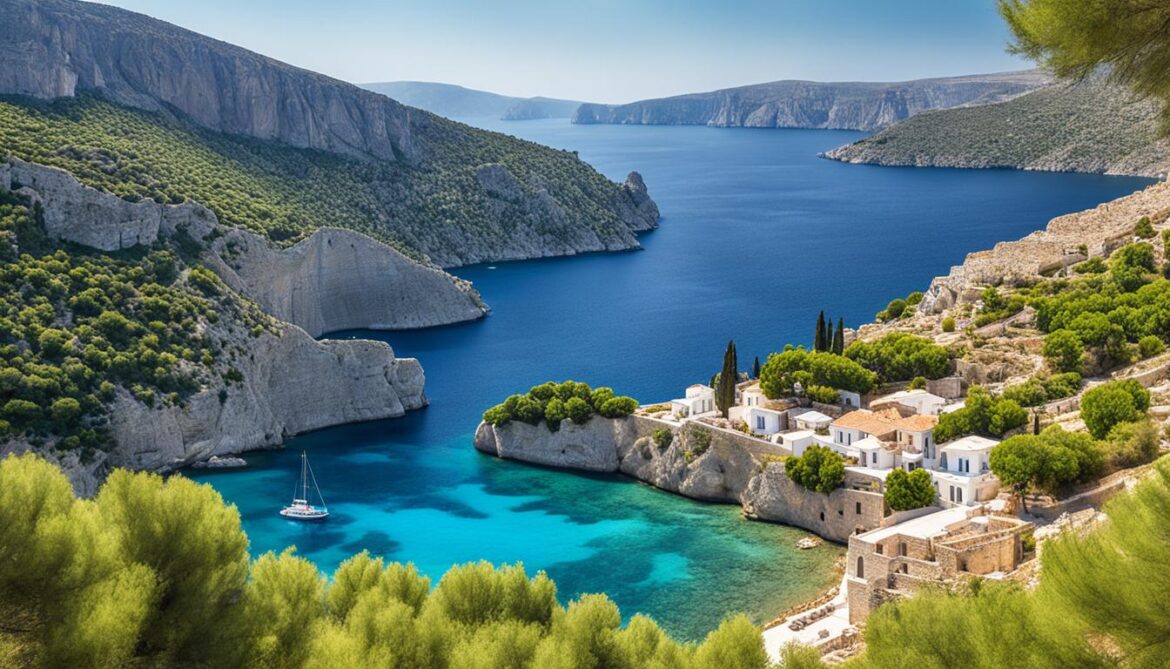
With the expansion of protected areas, collaboration with local communities, and the integration of SNS into conservation frameworks, Greece can build a future that prioritizes the preservation of its sacred natural sites and their invaluable cultural and ecological heritage.
The Role of Sacred Natural Sites in Global Biodiversity Conservation
Sacred natural sites have a global significance in biodiversity conservation. These sites provide a unique combination of spiritual and ecological values, offering refuge for diverse species and ecosystems. The protection of Sacred Natural Sites (SNS) is not only important from a cultural and spiritual perspective, but it also contributes to global conservation goals. By safeguarding these sites, we can preserve both the sacred and ecological heritage they hold.
Recognizing the role of SNS in biodiversity conservation requires cross-cultural perspectives and the integration of traditional knowledge with scientific research and conservation practices. These sites are deeply rooted in different cultures around the world, and understanding their spiritual and ecological importance requires collaboration and respect for diverse perspectives.
“Sacred natural sites hold immense value in terms of biodiversity conservation. These sites act as sanctuaries, offering protection and a sense of reverence for both the natural world and the communities that hold them sacred.”
By acknowledging the spiritual and ecological significance of SNS, conservation efforts can be strengthened. They provide not only a space for the preservation of unique ecosystems but also a source of inspiration and connection to nature. Moreover, these sites often display a high level of ecological integrity, reflecting centuries of sustainable land and resource management practices.
The global significance of SNS is evident in the presence of sacred sites in diverse ecosystems and geographical regions. From sacred groves in India to sacred forests in Greece, these sites are an integral part of the cultural and natural heritage around the world. Protecting these sites ensures the preservation of biodiversity hotspots and contributes to the overall health of the planet.
Protection of Spiritual and Ecological Values
The protection of SNS goes beyond conserving biodiversity; it also safeguards the spiritual and cultural values associated with these sites. These values are deeply rooted in the traditions, beliefs, and practices of indigenous and local communities. By recognizing and respecting these values, we can foster a harmonious relationship between humans and nature.
Furthermore, the spiritual and cultural significance of these sites often translates into strong community-based conservation efforts. Local communities take on the role of custodians, ensuring the preservation and sustainable management of SNS. Their traditional knowledge and practices contribute to effective conservation strategies that work in harmony with nature.
Cross-Cultural Perspectives
Embracing cross-cultural perspectives is essential for understanding and conserving SNS. The diverse traditions, beliefs, and practices associated with these sites offer valuable insights into sustainable land management and coexistence with nature. By engaging with indigenous and local communities, we can learn from their wisdom and integrate it into conservation frameworks.
The integration of cross-cultural perspectives also facilitates the development of respectful and inclusive conservation initiatives. It allows for the co-creation of solutions that address both ecological and social needs, ensuring the long-term sustainability of SNS and the well-being of local communities.
| Benefits of Recognizing SNS in Biodiversity Conservation | Examples |
|---|---|
| Preservation of unique ecosystems | Sacred groves in India |
| Conservation of threatened and endemic species | Sacred forests in Papua New Guinea |
| Enhancement of ecological resilience | Sacred mountains in Japan |
| Promotion of sustainable land and resource management | Sacred sites in Africa |
As we strive towards global biodiversity conservation, recognizing the role of SNS is crucial. These sacred sites hold immense value, both in terms of spiritual and ecological significance. By protecting and respecting these sites, we can ensure the preservation of diverse ecosystems and the well-being of indigenous and local communities. Through cross-cultural collaboration and the integration of traditional wisdom, we can forge a path towards a more sustainable and harmonious relationship with the natural world.
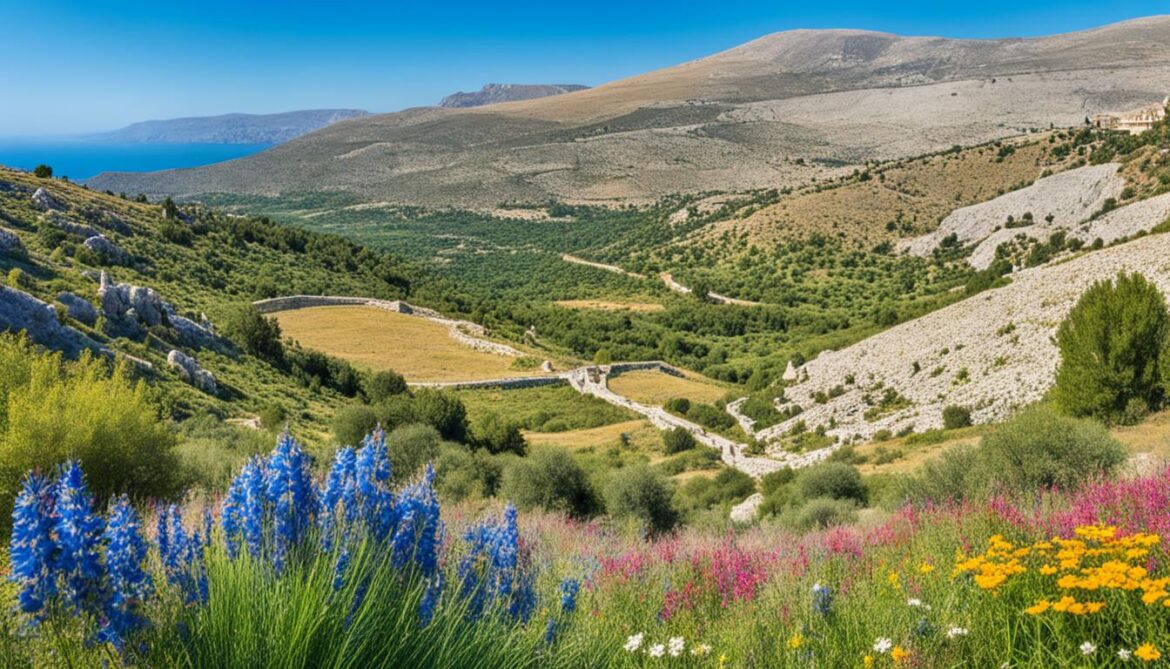
Conclusion
In conclusion, Greece’s sacred natural sites play a crucial role in biodiversity conservation. These sites hold immense spiritual significance for communities and contribute to the preservation of ecological diversity. Through extensive research, the positive effects of sacred natural sites on biodiversity have been acknowledged. However, further research is needed to address geographical and taxonomical gaps and advance our understanding.
Recognizing the importance of sacred natural sites is vital for their long-term preservation and protection. Sustainable management practices should be implemented to safeguard the unique cultural and ecological heritage they possess. Integrating sacred natural sites into conservation frameworks will ensure their sustainable management and contribute to the broader goal of biodiversity conservation.
With continued research, recognition, and sustainable management, Greece’s sacred natural sites can serve as shining examples of how to balance cultural, spiritual, and ecological values for a prosperous future.






